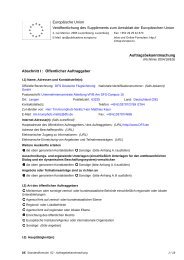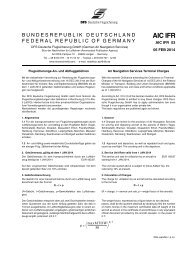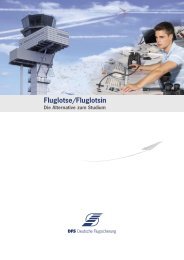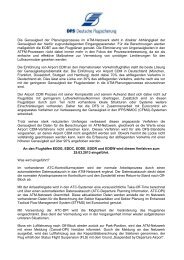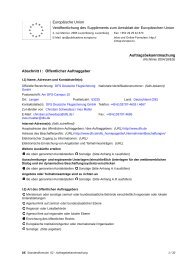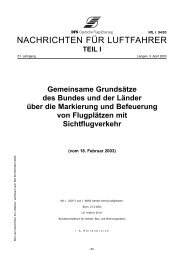TE im Fokus 02/2013 - DFS Deutsche Flugsicherung GmbH
TE im Fokus 02/2013 - DFS Deutsche Flugsicherung GmbH
TE im Fokus 02/2013 - DFS Deutsche Flugsicherung GmbH
Sie wollen auch ein ePaper? Erhöhen Sie die Reichweite Ihrer Titel.
YUMPU macht aus Druck-PDFs automatisch weboptimierte ePaper, die Google liebt.
Informationen aus dem Bereich Forschung und Entwicklung<br />
der <strong>DFS</strong> <strong>Deutsche</strong> <strong>Flugsicherung</strong> <strong>GmbH</strong><br />
8.1 False Target Origins<br />
The origins of WAM false targets either could be<br />
within the WAM system itself or generated by<br />
various external effects. Each multilateration calculation<br />
usually has localization ambiguities<br />
through multiple mathematical solutions. Therefore,<br />
each multilateration result is being checked<br />
with false target mechanisms. A further reason<br />
for WAM internal false targets are inaccurate<br />
positions for out-of-coverage areas due to poor<br />
ground station coverage and/or geometry in outof-coverage.<br />
External influences causing WAM false targets<br />
might be introduced by malfunctioning transponders,<br />
certain effects of the radio field and<br />
errors generated by human interaction.<br />
The following Figure 17 summarizes the most<br />
<strong>im</strong>portant effects observed during the qualification<br />
tests of the PAM-FRA WAM sensor:<br />
caused by… WAM sytem external effects<br />
(e.g. transponder (XPDR),<br />
radio field (RF),<br />
human interaction (HUM))<br />
false targets<br />
localization ambiguities<br />
<br />
multiple mathematical solutions<br />
Inaccurate positions for<br />
out-of-coverage area<br />
poor ground station coverage<br />
and/or geometry in out-of-coverage<br />
Detection issues<br />
Fig. 17: False target origins<br />
XPDR: Ground bit not set correctly<br />
XPDR: wrong altitudes reported<br />
(especially if A/C is on ground)<br />
RF:<br />
multipath / reflections<br />
HUM: Pilot handling errors<br />
switching on/off in air,<br />
altering from Mode A to Mode S and vs<br />
XPDR: “P4” issue on transponders<br />
(w/o same Mode A code)<br />
XPDR: Transponders with<br />
address alternation<br />
8.2 Conclusion from False Track Analysis<br />
Different false target types require different detection<br />
mechanisms.<br />
If the detection mechanism identifies only false<br />
target “candidates” a confirmation could only be<br />
achieved using another detection mechanism or<br />
by an individual case analysis (ICA). Therefore,<br />
the WAM false target analysis is complex and<br />
t<strong>im</strong>e consuming because usually large amounts<br />
of data need to be evaluated.<br />
The development of a false target detection<br />
mechanism dedicated for WAM systems (a priori/<br />
a posteriori) needs further attention.<br />
9. Conclusion<br />
The performance of a WAM system is strongly<br />
dependent on the environment (geographic, traffic,<br />
radio field), the interrogation strategy and<br />
operational requirements (e.g. update rate, data<br />
latency). In addition to common surveillance system<br />
performance requirements WAM systems<br />
have specific performance requirements which<br />
require either modified or new methods of performance<br />
testing and adequate test tools.<br />
The examples of probability of target detection<br />
analysis and data latency analysis showed that<br />
even if test approaches for these surveillance<br />
performance parameters do exist, it is required<br />
that a surveillance sensor specific adaptation<br />
needs to be identified, <strong>im</strong>plemented and verified<br />
in the corresponding test tools.<br />
The current test approaches and tools available<br />
are still oriented on the needs of radar performance<br />
analysis. Therefore, additional work is<br />
required to standardize the test approach also for<br />
the new surveillance sensors WAM and ADS-B<br />
as well as to <strong>im</strong>plement and qualify test tools for<br />
common use.<br />
The preferred solution would be an integrated<br />
test suite with s<strong>im</strong>ilar performance analysis for all<br />
different types of surveillance sensors, taking into<br />
account their specific characteristics. Furthermore,<br />
the sensor specific performance parameters<br />
should be considered as well.<br />
The results of this performance analysis shall<br />
directly indicate compliance to surveillance performance<br />
standards like the EUROCONTROL<br />
“Specification for ATM Surveillance System Performance”<br />
(ESASSP) [2] or the EUROCONTROL<br />
“Generic Surveillance” (GEN-SUR) document<br />
currently in consolidation.<br />
Therefore, a significant amount of effort of international<br />
harmonization and standardization<br />
needs to be carried out in order to set up performance<br />
test methods providing comparable results<br />
for the new surveillance technologies ADS-<br />
B and WAM.<br />
Data Performance Analysis of WAM Systems<br />
Ausgabe 2/<strong>2013</strong> Seite 13



